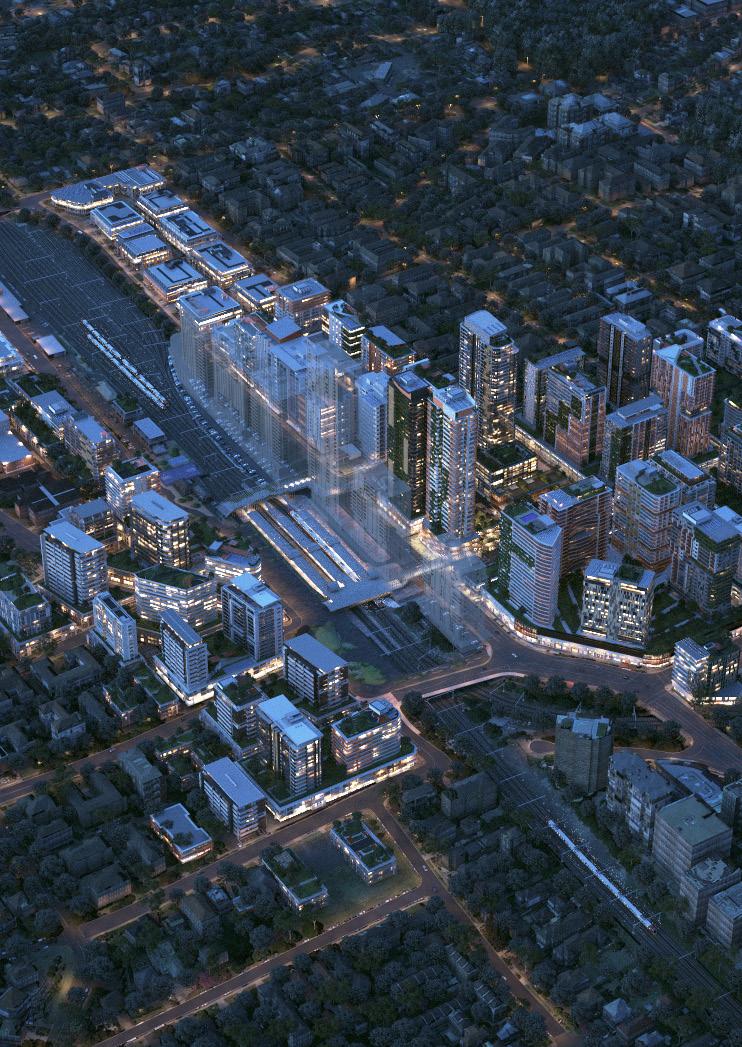
9 minute read
ATTACHMENT – SINSW SUBMISSION
– HORNSBY TOWN CENTRE MASTERPLAN
Demand for Educational Facilities
The draft Master Plan falls within the intake areas for Asquith Public School (PS), Hornsby South PS, Hornsby North PS, Waitara PS. Secondary school intake areas are currently under review. Nearby secondary schools include Asquith Boys High School (HS), Asquith Girls HS, Ku-Ring-Gai HS, Turramurra HS and St Ives HS. Based on a review of the existing education infrastructure and the projected demand expected to result from the draft Masterplan, additional school infrastructure (within the existing school sites) will likely be required to support this growth.
As a first preference and where appropriate, the Department of Education will optimise use of existing assets through:
Realigning school intake areas to appropriately manage growth in existing facilities where possible.
Monitoring enrolments to provide priority to students living in the local school intake area.
Renewing and/or reclassifying existing assets to provide contemporary teaching spaces and learning environments for students.
Increasing the size, amenity and functionality of existing schools to manage growth whilst providing greater curriculum choices where possible
Using temporary classrooms to manage short term fluctuations in enrolment levels
Working with schools and the wider department in identifying operational actions to increase enrolments in schools where there is capacity
The above options are subject to project funding and due diligence work to support proposed upgrades.
In cases of sustained and stable enrolment that are unable to be met through expanded facilities, The Department of Education provides new schools as necessary, having regard to the context and prioritisation of needs across the state. There are currently no announced primary or secondary school projects for the Hornsby LGA.
SINSW is committed to working with Council to ensure schools are supporting community needs and continue to be appropriately resourced to respond to changes in the student population
Development in the Vicinity of Existing Schools
Future development around existing schools should be undertaken in consultation with SINSW to ensure that the school is central to the place values of this development and that existing schools can continue to comply with each of the relevant controls contained to DoE’s ‘School Site Selection and Development Guide’ (2020) and DoE’s Educational Facilities Standards and Guidelines (EFSG). This includes compliance with sun access and overshadowing controls.
SINSW request ongoing consultation regarding any future development in close proximity to existing school sites
Active Transport and Access
SINSW has reviewed the Transport Plan (prepared by WSP) and note that connections to schools form part of the transport directions for the draft Masterplan. SINSW also supports the utilisation of the NSW Governments Movement and Place Framework (MAPF) to guide transport planning for the study area.
The MAPF’s core ‘Amenity and Use’ and 'Primary Schools' Built Environment Indicators are of particular importance to SINSW, as these encourage urban designers to consider the impact on adjacent places/uses, as well as emphasising movement that supports place. The 'Primary Schools' indicator provides two specific metrics to judge the effect of infrastructure on the accessibility of public schools in an area; these being walkability and public transport access. These metrics require designers to assess whether proposed infrastructure facilitates access to primary school facilities (or public transport connections to schools) or whether it exacerbates gaps in the network.
The primary school-focused MAPF amenity indicator can be accessed via the link below: https://www.movementandplace.nsw.gov.au/place-and-network/builtenvironment-indicators/primary-schools
While SINSW is generally supportive of the active transport improvements proposed under the draft Plan, it is unclear that how these will connect with the wider LGA’s active transport network, in particular how these will connect to existing school transport paths. Further, SINSW request that the proposed active transport infrastructure be delivered as part of Stage 1 of the draft Plans implementation, asearly implementation ofthese workswill achievegreateractive transport mode share for the Town Centre.
Infrastructure Contributions
Itis unclear from the exhibited documents whether the existing local contributions framework will be amended to accommodate the draft Masterplan (if approved).
Separate to the matters addressed above, SINSW note that Council’s Section 7.12 Development Contributions Plan currently levies contributions on ‘Educational Establishments’ over $100,000. No specific exemptions are apparent for state education facilities. SINSW requests that Council consider amending this plan to explicitly exclude government schools from the payment of contributions. This is considered appropriate, as:
DoE, in conjunction with SINSW, provides essential social infrastructure for the direct benefit of the local community.
Development provided by the Crown with an underlying philosophy of community service, such as a school, should not be levied a contribution as the material public benefit that is derived from the development exceeds any demand that it creates on existing infrastructure
Public schools in NSW are required to provide a suite of complementary facilities (such as open space) to service the needs of the student population. Further, these sites are often made available for community use (outside school hours) as a result of joint use agreements, facilitated via a Memorandum of Understanding with the local Council
In addition to the above, SINSW request that Council also consider amending the LGA’s Contribution Plans to include the following:
Requirements for public domain, transport and other infrastructure works required to support public schools around the core study area.
The collection of specific contributions from new residential developments. These could be used to support, amongst other things, social education programs around active transport within the Hornsby town centre.
The implementation of these recommendations within the relevant local contribution plan for the LGA will ensure projected growth resulting from the draft Masterplan is appropriately accommodated for and allow greater sustainable travel to and from schools. This also corresponds with the content of Planning Circular D6 (as updated) which relates to the application of contributions to crown development
Ms Katherine Vickery Manager, Strategic Planning Hornsby Shire Council
296 Peats Ferry Rd HORNSBY NSW 2077
By email:
hsc@hornsby.nsw.gov.au
Dear Ms Vickery
Thank you for providing the NSW Environment Protection Authority (EPA) with the opportunity to comment on Hornsby Shire Council’s Master Plan (the Plan), which is currently on exhibition until 30 September 2022.
The Plan makes a series of recommendations to facilitate the revitalisation of Hornsby as a growing strategic centre and encourages mixed use development around the Hornsby train line and station.
The EPA provides its comments on the Plan below at Annexure A
If you have any further questions about this submission, please contact Lauren Musgrave, Strategic Planning Unit, on (02) 9585 6840
Yours faithfully
Justin Hillis A/Unit Head, Strategic Planning Unit 29/9/2022
Annexure A
Noise impacts
The Plan envisages that medium and high-density residential housing and commercial uses will be developed in proximity to the Hornsby town centre
The Plan would be strengthened by considering potential noise and vibration impacts on current and future sensitive receivers, including residents, who will be located in proximity to rail lines and busy roads in Hornsby. These considerations should be guided by the Development near rail corridors and busy roads – interim guideline 2008 (Department of Planning, 2008) (Interim Guideline) and the NSW Road Noise Policy (Department of Environment, Climate Change and Water, 2011).
Additionally, the encouragement of the night-time economy in the Plan should be balanced against the need to protect current and future residential receivers in proximity to commercial uses from adverse noise impacts.
Air quality
Given the proposed proximity of sensitive receivers to busy roads in the area, the Plan should also expressly consider ways to enhance air quality and minimise adverse impacts on residents (and other sensitive receivers) from vehicle emissions. Therefore, the EPA recommends that the Plan reference and seek to implement principles contained in the Interim Guideline regarding air quality, as relevant (see Pt C, s 4).
Water quality
The Plan encourages the implementation of watersensitive urban design principles. The EPA agrees with this approach but recommends that the Plan be amended to encourage the implementation of the Risk-based Framework for Considering Waterway health Outcomes in Strategic Land-use Planning Decisions (Office of Environment and Heritage and EPA, 2017). This amendment is consistent with Action 64 of the North District Plan (which applies to Hornsby), that is, to "improve the health of catchments and waterways through a risk-based approach to managing the cumulative impacts of development including coordinated monitoring of outcome".
Waste
The EPA recommends that the Plan is amended to encourage better practice waste management. The Plan should reference and encourage the implementation of the Better practice guide for resource recovery in residential developments (EPA, 2019). The Guide provides strategic planning tools to ensure that waste is managed effectively for mixed use residential developments. The Plan should also be guided by the NSW Waste and Sustainable Materials Strategy 2041 (Department of Planning, Industry and Environment, 2021) and the Circular Economy Policy Statement: Too Good to Waste (NSW Government, 2018).
The Council of the Shire of Hornsby
PO Box 37
HORNSBY NSW 1630
ATTENTION: Fintan Langan
Dear Sir/Madam,
Strategic Planning Instrument
LEP Amendment – Draft Proposal
Your reference: F2018/00321-003
Our reference: SPI20220819000093
Date: Friday 10 March 2023
Hornsby Shire Council is emailing to inform you that the draft Hornsby Town Centre Masterplan is on public exhibition yoursay.hornsby.nsw.gov.au/hornsby-town-centre-masterplan
I refer to your correspondence dated 10/08/2022 inviting the NSW Rural Fire Service (NSW RFS) to comment on the above Strategic Planning document.

The NSW RFS has considered the information submitted and provides the following comments.
The NSW RFS notes that a small portion along the western side of the outlined area of the Hornsby New Town Centre Masterplan is mapped as bush fire prone land. This land between 316 and 296, 187 to 201 Peats Ferry Road and 2-4 Dural Road are demarcated for increase in residential density. In this regard, any future residential development on bush fire prone land must demonstrate compliance with chapter 5 and section 8.2 of Planning for Bush Fire Protection 2019.
For any queries regarding this correspondence, please contact Elaine Chandler on 1300 NSW RFS.
Yours sincerely,
Kalpana Varghese Supervisor Development Assessment & Plan Built & Natural Environment
Katherine Vickery Manager Strategic Land Use Planning
Hornsby
Shire Council
Email: hsc@hornsby.nsw.gov.au
RE: Draft Hornsby Town Centre Masterplan
After reviewing the draft town centre masterplan and noting a substantial increase in density and population I ask that council consider and make provisions in the masterplan allocation for:
• an increase in police services to cater for population increase anticipated
• an allocation for a new police station (or at least a proposed uplift to the current building address) and Local Court House services
Our concern is that the current station building size and current staff numbers would not be able to serve a community effectively without an increase in both building capability and an increase in police numbers.
Whilst understanding that funding comes from the NSW Government, the Commander and I are of the opinion that when council is master planning, consideration must be given to services required at Hornsby Police Station so we can maintain the ability to service the needs of the community in the future that’s in line with your strategy, targets, density and population growth.
Yours faithfully,

M Mathieson
A/ Commander
Ku-ring-gai Police Area Command
30 September 2022
30 September 2022
Fintan Langan
Hornsby Shire Council flangan@hornsby.nsw.gov.au
RE: Draft Hornsby Town Centre Masterplan
Thank you for consulting with Sydney Water regarding the Draft Hornsby Town Centre Masterplan, which sets Hornsby Shire Council’s future direction for growth within Hornsby Town Centre. Sydney Water has reviewed the available documents and provides the following comments to assist in progressing the lodgement and in planning the servicing needs of the proposed development.
Sydney Water notes that projected long-term dwelling forecast predicted by the Draft Hornsby Town Centre Masterplan of 4,500 is lower than that of the 6,500-7,500 identified for the Town Centre within the Hornsby Shire Council Housing Strategy 2020.
Growth Data
• Sydney Water supports government-backed growth initiatives within our area of operations and endeavour to provide services in a timely and prudent manner that delivers cost effective water and wastewater infrastructure whilst not impacting our current customer base economically, environmentally, or unduly impacting current service levels.
• In order to do fully support all growth and developments and to fully assess proposed developments, we require the ultimate and annual growth data for this development as noted in the attached appendix, be fully populated and returned to Sydney Water.
• Sydney Water acknowledges that timescales and final growth numbers may alter however, in order to provide robust servicing advice and to investigate the potential for staged servicing to meet timescales, we require a realistic indication of demand and timescales. Failure to provide this may result in Sydney Water being unable to formulate proper planning requirements.
• The growth data should be completed and provided within 4 weeks of this letter.
If you require any further information, please contact the Growth Planning Team at urbangrowth@sydneywater.com.au or your Account Manager, Raniya Parappil at raniya.parappil@sydneywater.com.au.
Yours sincerely,
Kristine Leitch Commercial Growth Manager City Growth and Development, Business Development Group
Sydney Water, 1 Smith Street, Parramatta NSW 2150
APPENDIX 1: GROWTH DATA FORM (emailed)





